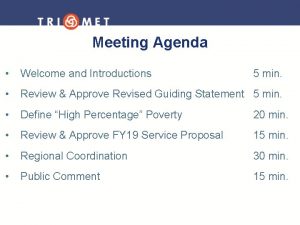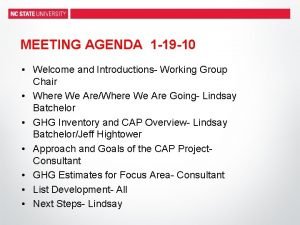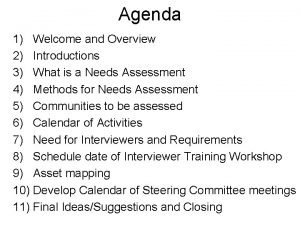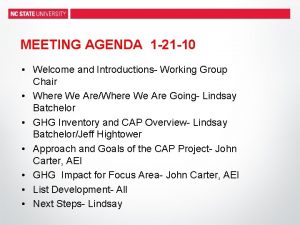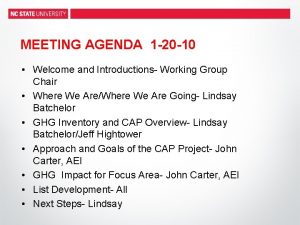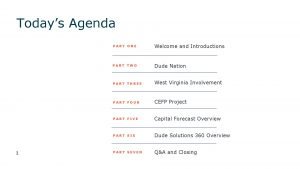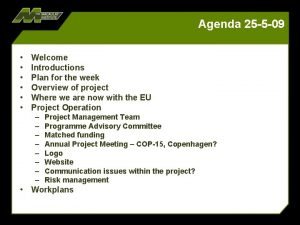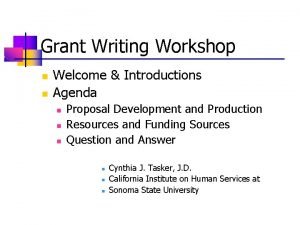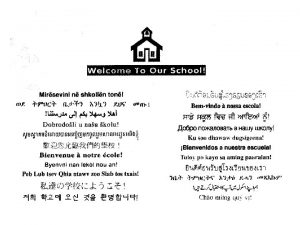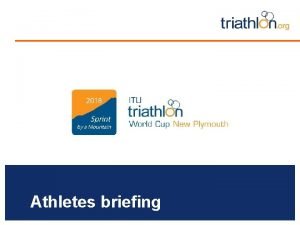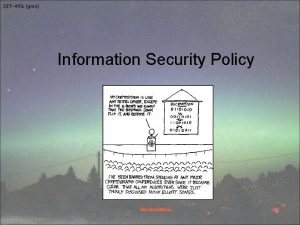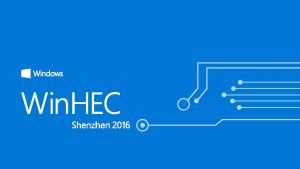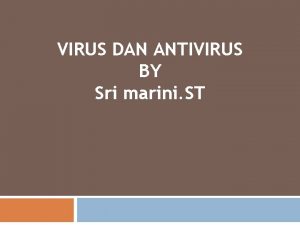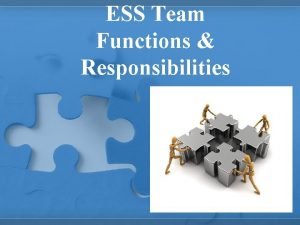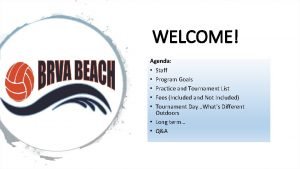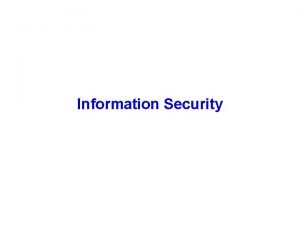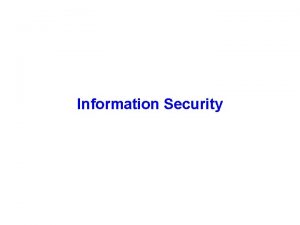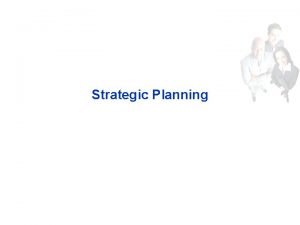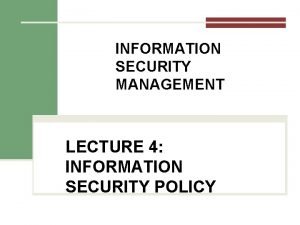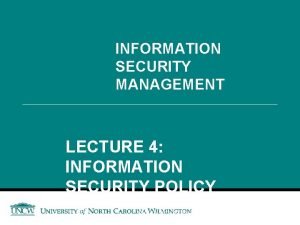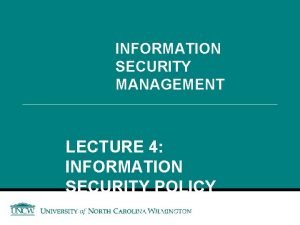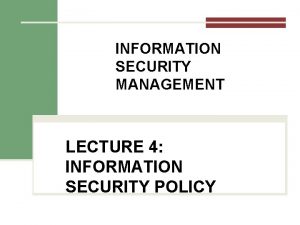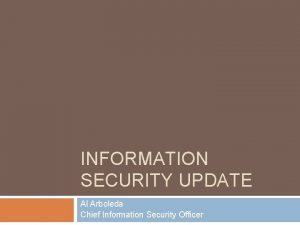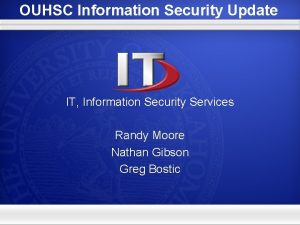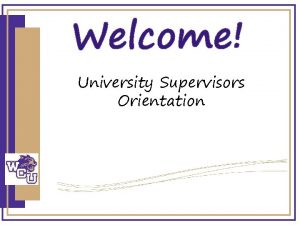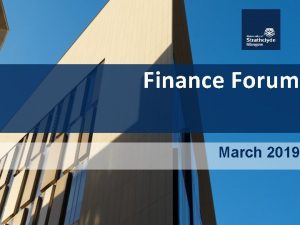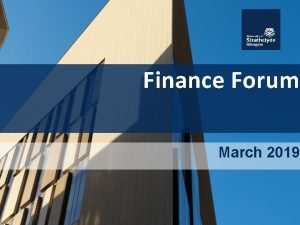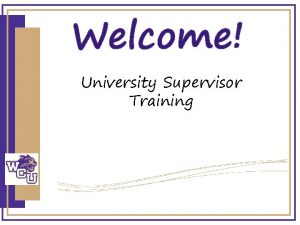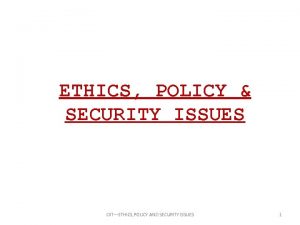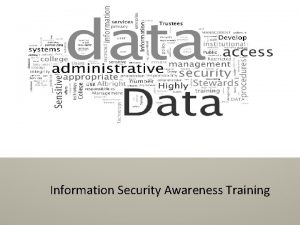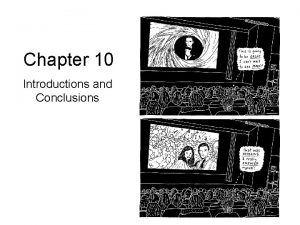Agenda Welcome and Introductions Information Security Policy Update























- Slides: 23


Agenda Welcome and Introductions Information Security Policy Update IT Information Updates Workstation Lifecycle Replacement Student Printing Pilot HEAF Improvements Current & Upcoming Projects Open Discussion/New Business

Information Security Policy Update ØSecurity Policy – 4. 197 § Addresses TAC 202 C and NIST 800 -53 § 329 Controls (Moderate, High) § 115 Controls (Low) § Information Security Handbook – Summer 17 § Data Classification (Confidential, Sensitive, Public) § Information Resources Usage and Policy Agreement § Acceptable Usage

Information Security Risk Assessment Ø A systematic process of evaluating the potential risks that may be involved in a projected activity or undertaking and assessing potential organizational impacts. § Identification § Hazards § Assets at Risk § Impacts § Yearly Activity § Completed with Data Owners § Mitigation Plans Based On Findings

Information Security Awareness ØSecurity Awareness § Yearly Training for 2016 § 99 Day Campaign § Second Chance § Account Lock § Ongoing – Simulated Phishing § Mar 17 – 3. 5% § Apr 17 – 8. 2% § May 17 – 9. 2 % § Jun 17 – 6% § Jul 17 – 4. 9% § Aug 17 – 3. 4% § Ongoing – Info. Security Alerts § 2017 Security Awareness Training § Aug 26 th – Dec 15 th (111 Days) § Information Resources Use and Policy Agreement

Information Security Email ØEmail § Inbound Filtering § URL § Malicious Code § Block lists § Volume § 30 Day Inbound – 3. 7 M, 3. 3 M Blocked § 30 Day Outbound – 114. 5 K § Encryption § 30 Day Inbound – 58. 5% § 30 Day Inbound – 80. 3%

Information Security Infrastructure Ø Internet Immunization Project § Global Cyber Alliance § Sanitized DNS § Blocks Known Bad Actors Ø Dynamic Threat Blocklists § Firewall Based § Lists Updated Daily Ø Vulnerability Blocklists § Firewall Based § Lists Updated Hourly § Blocks Threats Based On Severity Ø Information Sharing § MS-ISAC § REN-ISAC § DHS Stop. Think. Connect. § SANS Institute

Information Security 2017 Trends Ø 2016 Perspective – Low Lights § 3000 Data Breaches § 2. 2 Billion Records Exposed § Yahoo Breach Made Public - 1. 5 Billion User Accounts Exposed Ø 2017 Trends § Nation State Hacking – Russia, China, Iran, North Korea § Disruptive and Attention Seeking Groups § For Profit Cybercrime – Made To Order Malware § Cheap, Devastating § Designed To Be Monetized § Hacktivism – Anonymous, ANT, Political Groups

Information Security Best Practice Key Best Practices

Information Security Current Activity Actions To Aid Best Practice

Faculty/Staff Workstation Lifecycle Replacement Program Ø The Problem Ø Total Desktops Ø 2, 206 Total Ø 1, 225 (Minus Labs and 2012 or older) Ø 981 (under 5 years) Ø Total Laptops Ø 749 Total Ø 463 (2012 or older) Ø 286 (under 5 years) Ø Tablets Ø 223 (most all under 5 years) ØPotential Cost Ø 1, 225 + 463 = 1, 688 Ø 1, 688*1, 000 = $1, 688, 000 Ø $1, 688, 000/5 = $337, 600

Faculty/Staff Workstation Lifecycle Replacement Program Ø Potential Solution Ø 765 Faculty and Staff Ø 765 * $1, 000 = $765, 000 Ø $765, 000/5 - $153, 000 Ø HEAF Request $160, 000 Ø Replace as many devices as possible Ø Obtain hot swap devices for troubleshooting Ø Bulk purchasing

Faculty/Staff Workstation Lifecycle Replacement Program Ø Draft Guidelines First Year Ø Ø Ø 5 Year Replacement Goal Primary Device Only Oldest Computers first Base Computing Standards Above base or secondary devices not included Ø Not included Ø Lab Computers Ø Student Computers Ø Secondary Devices

Faculty/Staff Workstation Lifecycle Replacement Program Ø Reclamation Ø This first year many likely headed to surplus Ø If device is still supportable, IT will work with department/college on replacement first. Ø IT will then look at greatest campus need for replacement (GA, TA, student computers)

Student Printing Ø The Issue Ø Student Printing in Four Computer Labs Ø Fall 2016 = 1, 000, 463 pages Ø Spring 2017 = 958, 302 pages Ø Summer 2017 = 70, 707 pages Ø Total = 2, 029, 472 pages ØWhat this Looks Like Ø Ø Ø Equivalent to 4, 059 reams of paper annually 11 reams per day average 5, 560 pages per day average One tree is between 8, 000 and 20, 000 pages 4 printers are using up from 101 to 253 trees annually

Student Printing Ø Potential Solutions Ø Wepa Pilot Ø 4 Kiosks Ø CSC, Moffett, Legacy, Prothro-Yeager Ø $5 print credit, equivalent to 100 pages Ø Additional functionality Ø Card swipe, print from cloud storage, USB, D 2 L, web

Student Printing ØImpacts: Ø Total of 3, 860 students printed last fall in labs Ø Of those 660 printed 500 or more pages Ø 180 students printed 1, 000 pages or more ØPotential Next Steps Ø Reduce $100 print credit which is equivalent to 2, 000 pages to $25 for Spring semester (500 pages).

Information Technology HEAF Improvements ØWireless Improvements ØDisaster Recovery ØClassroom Upgrades § Dillard Hall Upgrades § Will be reaching out to colleges for next summer upgrades § Computer Lab Upgrades § Server Upgrades § Network infrastructure Upgrades § Hardin South

Information Technology Current Project Highlights Ø Banner 9 Ø Current Banner INB will be called Admin Pages in Banner 9 (Summer 2018) ØFlower Mound Campus Ø Scheduled to open next semester for classes Ø HSHS – New Data Center Ø Construction to start this semester, completed by Spring 2019 Ø Radius CRM Ø Implementing this fall

Information Technology Current Project Highlights Ø Degree Works Ø January/February Go Live ØTime. Clocks Plus ØDomain Name Change ØOthers in the Queue: Ø Ace. Ware Ø Track. IT Ø Team. Mate Ø Handshake Ø CS Gold Upgrade Ø TLETS Upgrade Ø Alertus Ø Digital Signage Ø E-Signatures

Information Technology Upcoming Project Highlights Ø Domain Change Ø Moving from mwsu. edu to msutexas. edu Ø 6 months plus 6 month extension. Ø 2018 Calendar Year Ø What to Expect Ø Email change Ø url changes (websites, research, publications) Ø Personal accounts linked to mwsu. edu

Information Technology Upcoming Project Highlights ØTwo Current Open Positions ØProgrammer Analyst 2 ØAudio Visual Tech

Ø Questions Ø Comments Ø Concerns
 Agenda welcome and introductions
Agenda welcome and introductions Agenda welcome and introductions
Agenda welcome and introductions Agenda welcome and introductions
Agenda welcome and introductions Meeting agenda welcome and introductions
Meeting agenda welcome and introductions Agenda welcome and introductions
Agenda welcome and introductions Agenda welcome and introductions
Agenda welcome and introductions Meeting agenda welcome and introductions
Meeting agenda welcome and introductions Agenda welcome and introductions
Agenda welcome and introductions Agenda welcome and introductions
Agenda welcome and introductions Parent orientation agenda
Parent orientation agenda Agenda welcome and introductions
Agenda welcome and introductions Agenda welcome and introductions
Agenda welcome and introductions Recovery techniques based on immediate update
Recovery techniques based on immediate update Security policy and integrated security in e-commerce
Security policy and integrated security in e-commerce Security security security
Security security security Xkcd specifications
Xkcd specifications Explain about visa international security mode
Explain about visa international security mode Cnss security model คือ
Cnss security model คือ Agenda sistemica y agenda institucional
Agenda sistemica y agenda institucional Microsoft windows 10 security update
Microsoft windows 10 security update Microsoft security essential tidak bisa update
Microsoft security essential tidak bisa update Agenda welcome
Agenda welcome Welcome session agenda
Welcome session agenda Welcome agenda
Welcome agenda
